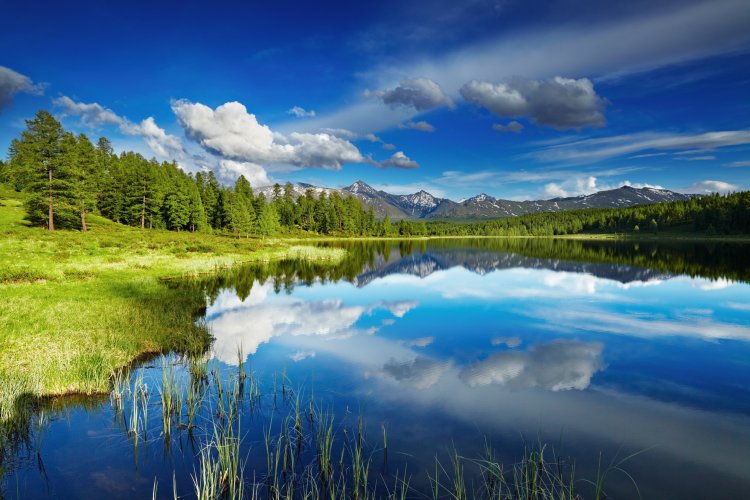The water mass in lakes consists of epilimnion, metalimnion and hypolimnion (derived from the Greek “limnos” meaning “lake”), i.e. the upper, middle and lower layers of the lake. The layer boundaries are determined by water temperature. The epilimnion is normally warm in the summer, the temperature being the same throughout the layer, though slightly lower in the lower part. The temperature of the epilimnion in midsummer reaches 20 to 25 degrees. In the lower part of the lake (in the hypolimnion), the temperature is also even but cold – within 5 to 6 degrees, though it may go slightly lower at times.
The middle part of the lake (in the metalimnion) is a zone with a steep temperature gradient. While in the upper part of the layer, the temperature may be around 20оС (similar to the epilimnion), it goes down to 7оС-10оС or even lower just 3-5 m down. For example, in the lake Glubokoye (Moscow Region), the temperature goes down from 20оС to 10оС.
There is the Glubokoye Ozero biological research station on the bank of the lake, which was founded in 1891. It has been engaged in hydrobiological work all this time. The station belongs to the Severtsov Institute of Ecology and Evolution of the Russian Academy of Sciences.
In a warm summer, the epilimnion is 5 to 7 m thick by the middle of the season, the metalimnion reaching 3-7 m or more, depending on how warm the water gets.At the end of the summer, the hypolimnion starts at 7-10 m and extends to the bottom. Lake Glubokoye is 32 m deep.
This clear stratification of the lake mass only exists where there is no water mixing caused by currents or wind-driven waves. The Glubokoye is not a large lake (with the surface area of around 60 hectares); it is surrounded by woods and somewhat exposed to wind. In large water bodies, the thermocline can be destroyed fast by water turnover.
Now, let’s look at what happens to the water in the spring. In the spring, the ice starts melting due to exposure to sun rays. Going through the ice, the rays heat the upper water layer, which passes the heat to the adjacent ice. So the ice melts from the bottom up as well as from the top down. In central Russia, water bodies de-ice in April or by early May, depending on the weather.
The water keeps getting warmer gradually, the temperature soon reaching 4оС. It should be noted that water has an anomalous property: its density peaks at 4оС (3.8оС to be more precise) rather than 0оС. Water is the heaviest (densest) at this temperature. The deeper layers of the lake have the temperature of around 3оС-5оС or slightly lower.
As a result, the heavy water moves down like an avalanche, displacing the water from the deeper layers. That’s how the spring turnover happens. The deeper layers of the lake are enriched with oxygen in the process, while the water mass, including the top layer of the lake, gets minerals. In the winter, the organic sediment (detritus) deteriorates (decays), with mineral salts being released into the environment. The mixing also removes undesirable gases, such as carbon dioxide, methane, and hydrogen sulphide from the deep water layers. Sunlight and mineral salts are good for microphytic algae, enriching the epilimnion with oxygen. The early spring mostly favors psychrophilic algae.
Water warms up gradually during the spring and summer, finally reaching 20оС-25оС. This happens by late July or early August. The epilimnion warms up slowly, giving off heat to the underlying layers. Warm water, being less dense, rests on top of the more dense cold water. If course, the layers may get mixed due to wind, in which case the stratification may not be so clear.
In central Russia, water temperature in water bodies normally goes up till early August, and then starts dropping again. Eventually, the temperature hits 4оС by early or mid October. Water becomes denser again and moves down like an avalanche. Another turnover happens – the fall turnover. The temperature in the lake becomes even, while the undesirable gases that accumulated in the layer next to the bottom mix with the main water mass and are released into the atmosphere. It is mostly methane and hydrogen sulphide, which are toxic for live beings. Enriched with oxygen, the deep layers become habitable. All this is repeated from year to year.
The top layer of the lake receives oxygen mostly produced by phytoplankton. Sometimes, the photosynthesis is so intense that the surplus oxygen is never released into the atmosphere. With zero wave, if you put your hand into the water and move your fingers briskly, the gas (oxygen) will shoot up to the surface like in a bottle of soda.
Plankton organisms that live in the water body die sooner or later. Many of those live from several days to a month or a bit longer. Those are microphytic algae, bacteria, zooplankton, etc. Dying, they sink slowly down the water mass. The smaller the particles, the slower they sink. Animals, such as maxillopoda and fish produce excrement, which sinks to the bottom as well. Bacteria that live in the water mass and at the bottom mineralize the organic matter, whereby mineral salts are released.
Deterioration (decay) of the organic matter is associated with oxygen consumption. There is no oxygen source at the bottom, oxygen coming only in the spring and fall. The result is a gradual decline in the amount of oxygen, from the bottom up. Thus, by the summer (after the spring turn-over), an anoxic zone may form at the bottom, spreading gradually to upper layers of the lake. Eventually, by the end of August – early September, up to 1/3 (sometimes even 1/2) of the lake mass may become anoxic. In the lake Glubokoye, anoxic water was observed at the depth of 15-20 m, the lake being 32 m in depth.
During the summer, a lot of organic matter sinks to the bottom of water bodies (due to the death of aquatic organisms, leaves and pollution of all kinds), which may deprive the entire mass of the lake of oxygen in the winter. That leads to massive fish die-offs and death of other aquatic organisms. Only ice-holes or artificial water aeration can save them. However, water aeration in a lake requires a lot of caution to avoid stirring the silt at the bottom and making the situation worse.
The fall and spring turnovers could be compared to breathing in a body. Expiration removes the undesirable gases, normalizing the gas composition in the lake; inspiration brings in oxygen to enrich the deep water layers.
What happens in the metalimnion? It is the layer with the greatest temperature difference. In the lake Glubokoye, in particular, it may reach 10-12 degrees. The temperature in the epilimnion, down to 7-8 m, is even, while down to 8-10 m it is much lower. The warm water of the epilimnion kind of rests upon colder, denser water.
Dead organisms, shells shed by moulting crustaceans, excrement, etc. sink. The particles are small (within a dozens of µm), so they sink very slowly. The thermocline impedes their movement down. The thermocline layer is denser than layers above it, so small particles that sink slowly as it is get caught in it. This is why there is a large number of various particles in the thermocline, especially after algae die. It is as if they lying in this layer, decaying gradually from exposure to microorganisms. This is why the metalimnion is figuratively called “the second bottom”. If the water were to be removed from the layer with a special device (bathometer), the suspension could be seen with a naked eye. A microscope would show flakes of particles stuck together. The sinking suspension is called detritus (derived from the Latin for “the act of rubbing away”).
The large amount of organic loadings in the metalimnion is favorable for bacteria, while concentration of food particles attracts zooplankton to the layer (crustaceans, rotifers and protozoa), which, along with bacteria, contributes to mineralization of the organic matter and consumption of oxygen. The oxygen level in the layer drops drastically. The intense destruction processes in the metalimnion result in the so called metalimnetic oxygen minimum in the layer. An interesting situation develops: there is a lot of oxygen in the epilimnion and enough in the hypolimnion, while it drops to the minimum in the metalimnion (sometimes down to the analytical zero).
In the lake Glubokoye, photosynthesis mostly occurs in the 2 m upper layer, while most algae are 5 m deep, above the thermocline layer, where there is enough biogenic elements. In terms of biomass, the layer was dominated by the cyanobacteriae Coelosphaerium kuetzingianum, Microcystis aeruginosa, Oscillatoria agardhii, green Sphaerocystis polycocca and the dinophyte Peridinium cinctum. This is because decomposition of organic matter results in the layer being enriched with mineral salts that the water is always low on, especially in the second half of the summer. Algae descend down to 4-6 m to access the minerals. There is little light at this depth, not enough for complete photosynthesis, but the algae gain access to mineral salts.
This work was completed within the Scientific School “Future of the plant and global changes in the environment” of the Moscow State University.
A.P. Sadchikov, Professor of the Moscow State University, Vice President of the Moscow Society of Naturalists
Photo: muha/Photo bank ru.123.rf






















